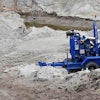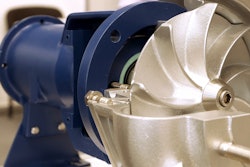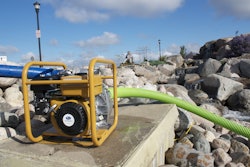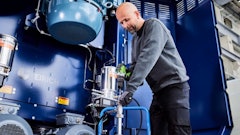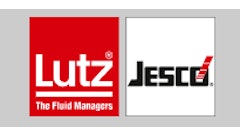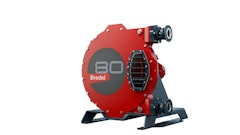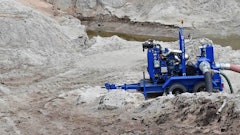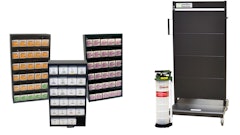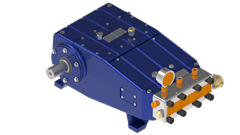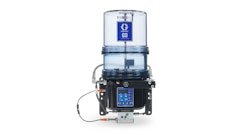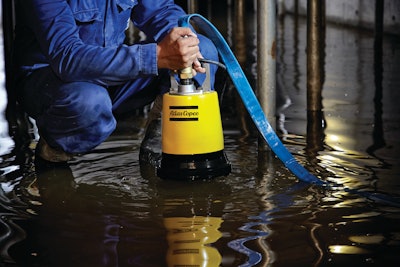
Submersible pumps can be an effective, inexpensive solution for dewatering a construction site. These encapsulated pumps can be completely submerged in liquid, and are most frequently used to transport drainage water or liquids with suspended solids from pits or tanks.
Today’s submersibles feature improvements in both pump and impeller designs that make them more efficient than past models. For example, non-clog impellers have become standard, and variable frequency drives (VFD) automatically regulate the speed of the pump for maximum efficiency.
Slimline submersible pumps are also available to fit inside pipes as small as 4 in. in diameter. Contractors can place perforated casing pipes with a pump nearly anywhere on a jobsite. Special floats that turn the slimline pump on and off can be used for confined spaces, depending upon water levels.
The choice to use a submersible over other pump types is relatively straightforward. “There is a simple rule of thumb to choosing a submersible pump over an end drive centrifugal pump,” says Jerry Soto, submersible pump manager, Griffin Pump & Equipment, Inc. “When suction lift is greater than 25 ft., a submersible pump should be used.”
Of course, once you’ve identified a submersible as the appropriate solution, there are other factors to consider to ensure it can provide the dewatering results required.
Provide Stable Power
Submersibles come in electric- or diesel-powered versions. Electric-powered units are more common mainly for their ease of installation, smaller footprint and low maintenance requirements.
Knowing the type and quality of power available on site is important for any pump installation. “Electric power comes in many voltages and phases (230 volt, three phase; 460 volt, three phase; 110 volt, single phase, etc.) and can be unreliable in remote locations,” notes Majid Tavakoli, vice president of applied products, Thompson Pump. “Poor quality power will cause any pump to fail eventually.”
“For three-phase pumps, the supplied voltage may vary 10% above or below the rated pump motor voltage,” Soto points out. “Provide the pump with as good and stable of power as possible. The more the supplied voltage varies (a three-phase 230-volt pump will operate on as little as 208 volts of power or as much as 253 volts of power), the more risk for damaging the pump’s motor.”
A Solid Matter
Submersibles also come in three basic types. Dewatering pumps are the most commonly used on construction sites.
“This type of pump is made to handle smaller abrasives like sand, smaller stones and clay up to about 1/2 in.,” says Stan Rockovich, submersible distribution manager, Xylem Dewatering Solutions. “Depending on the solids, an open or closed impeller design can be used. A closed impeller is used in the toughest applications where high-chrome materials are present and where material completely passes through the impeller. Open impellers have two parts [that] must be maintained or wear between them will decrease performance.”
Sludge pumps are used for pumping water with larger solids (up to about 3 in.) and higher densities. These pumps are designed with a Vortex impeller to reduce wear. Since most of the pumped water doesn’t actually pass through the impeller, wear and clogs are minimized.
Slurry pumps are designed for the most demanding jobs where large and heavy abrasives must be pumped, such as fly ash and dredging applications. To cope with abrasives, the hydraulic parts of the pump are often made of NiHard 4, one of the hardest materials available. Optional agitators are offered to help re-suspend particles around the pump inlet.
Each dewatering application involves different levels of suspended solids. Determine the type, concentration and pH of these solids when determining which submersible pump to use.
Proper Size and Position
“Properly sizing the pump to the application is critical to efficient pumping. It’s important to know how much water you need to move and how fast you need to move it,” says Joe Moser, product line manager, pumps, Atlas Copco Construction Equipment. “If you undersize the pump, you risk overflowing the jobsite; if you oversize the pump, you risk pumping the hole dry.”
Sizing it right for the task will ensure optimal performance. “You invest in a pump to protect a jobsite and expect that pump to perform. With efficiencies and operating costs being what they are, when you invest in a quality pump sized appropriately for the job, you’ll get a lot more for your money,” says Moser.
“Proper positioning of the equipment is also essential when using a submersible pump,” adds Ola Hallgren, product and application manager, Xylem Dewatering Solutions. Make sure the pump is installed and sump is prepared appropriately for the application. “You want to ensure that the pump is properly suspended, supported or surrounded, depending on the application.”
“The pump should be submerged to avoid overheating and damaging the pump’s motor,” Soto explains. “For continuous operation, some pumps such as dewatering pumps can operate in low flow applications as the pumped fluid passes through the pump and across the motor to remove heat. Other pumps such as sludge or slurry pumps require the pump motor be three-quarters submerged or completely submerged to cool the motor, or will require a ‘cooling jacket,’ in which a fluid is circulated around the motor to dissipate heat. Many pumps will advertise that they can run dry for extended periods of time, but there are few pumps that can truly run dry.”
During installation, ensure there is suitable rotation of the pump and there are no sharp bends in the discharge hose and piping, Rockovich advises. The pump should also be submerged less than 65 ft. for a typical installation. Last but not least, implement a preventive maintenance program to care for the pump and piping system, valves, drains and vents in the piping line.
To make submersible pump selection and installation easier, professional assistance is available from pump manufacturers and dealers. “A dewatering expert can be helpful in assessing the proper approach to match jobsite conditions,” Moser points out. “Enlist the help of an expert before dewatering becomes necessary.”
Come armed with information (see checklist). “Make sure to perform due diligence when selecting a submersible dewatering solution,” says Tavakoli. “Start by having all the data necessary to select the right pump for the job. Designing the solution correctly from the start will net you the results you are looking for.”




